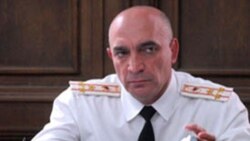By Karine Kalantarian
The controversial dispersal of opposition protesters camped in a major Yerevan square after the February presidential election failed to serve its main stated purpose, a senior police official said on Friday, raising more questions about the official version of events. Colonel Hovannes Tamamian, chief of the criminal investigations department of the Armenian police, stood by government claims that security forces moved into Liberty Square early on March 1 to confiscate weapons allegedly stashed there by opposition leader Levon Ter-Petrosian and his associates. But unlike other top law-enforcement officials, he stated that they failed to find most of those weapons because organizers of the tent camp were tipped off about the police operation.
“I did my best to keep the information secret,” Tamamian told an ad hoc commission of the Armenian parliament investigating the March 1 unrest in Yerevan. “But sadly, there was a traitor in our ranks”
“We knew that the number of people staying in Liberty Square should not exceed 300 [at dawn.] But when we arrived [at the square] there many more of them there. They were not sleeping and were ready to meet us with armed resistance,” he said.
The “traitor” mentioned by Tamamian is the former deputy chief of the police department of Yerevan’s Nor-Nork district who was sacked and arrested later in March for allegedly tipping off the opposition leaders several hours before the assault. The officer, Armen Nikoghosian, was tried and given a suspended prison sentence in late May.
According to eyewitnesses, security forces needed no more than 15 minutes to clear the square of Ter-Petrosian supporters demanding a re-run of what they consider a rigged election. Scores of campers were injured and arrested on the spot, while others managed to flee and regroup elsewhere in the city center.
The crowd rapidly grew in size as it barricaded itself at a sprawling street junction outside the Yerevan mayor’s office later in the day. At least eight civilians and two interior troops were killed in ensued pitched battles that ended the next morning after a state of emergency declared by then President Robert Kocharian.
Testifying before the parliamentary commission on Tuesday, the deputy chief of the national police, Major-General Sasha Afian, insisted that the police decided to break up the unsanctioned protest in Liberty Square only after the demonstrators led by Ter-Petrosian refused to allow them to search the square. He claimed that the police received on February 29 “reliable information” that the protesters will be handed firearms, explosives, iron bars and other weapons to stage a coup d’etat.
Armenian state television and other government-controlled channels repeatedly broadcast footage of what the police presented as weapons found in the square. The Armenian opposition insists that those were planted by the police to rationalize the use of force against peaceful protesters. It also says the security forces issued no warnings before attacking the crowd.
The official justification for the use of force has also been questioned by Armen Harutiunian, the state human rights ombudsman. “If fleeing demonstrators left guns behind them, then why is it that during their dispersal, which was accompanied by beatings and resistance, not a single gunshot was fired?” Harutiunian asked in an extensive report released in late April.
Tamamian was likewise asked by one of the commission members why the protest organizers did not remove all of the weapons, which the police claim were kept in the square, if they knew about the impending police assault. He skirted the question, saying only, “According to our operational data, there should have been more weapons and ammunition.”
Tamamian also said that the police did warn the protesters before using force. But he would not say if there is any video evidence of that.
(Photolur photo)




